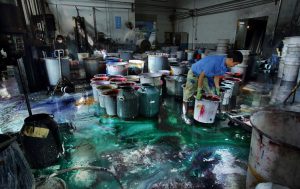Liu Qin (LQ): What are the aims of Redress?
Christina Dean (CD): ‘Redress’ means to set right, remedy or rectify. So, it is to make something ‘better’ and also, because of how the word sounds, it is also to change the way you dress. Sustainable fashion can mean many things and there are many approaches to sustainable fashion design from the materials used, to the production process and the social impact. One definition is “clothing that minimises the negative impact on the environment and maximises the positive impact on society.”
Within this broad definition, Redress focuses on reducing textile, water, energy waste and chemical use. More specifically, our EcoChic Design Award focuses on textile waste reduction through three sustainable design techniques -zero-waste, up-cycling and reconstruction. Twenty million tonnes of textile waste, originating from industry and consumers, is thought to be generated every year in mainland China. And an average of 296 tonnes of textiles were estimated to enter Hong Kong’s landfills every day in 2012, according to Hong Kong’s Environmental Protection Department.
At the industry level, the issue of sustainable design and sustainable production cannot be ignored anymore because the industry faces shortages and more competition for natural resources, which the fashion industry relies upon. The industry knows that sustainability is not a trend; it is here to stay. It also knows that sustainability is not just about morality; it’s also about money.
At the consumer level, the revolution we have seen in the food and health sectors is gradually taking place in fashion, albeit at a (much) slower pace. Fashion consumers around the world are waking up and becoming more aware about the need to know ‘how and who’ made their clothes.
LQ: Why did you choose “fashionable Chinese style” as the theme for your EcoChic competition this year?
CD: We wanted to draw attention to China because it has both a large emerging consumer group, and consumers who have more open ideas about sustainable fashion. There is a general trend where Chinese fashion consumers are increasingly moving away from once-aspirational western high end brands and developing their own new sense of style. In this, there is a more creative respect and interest towards China’s own creative and cultural forces.
LQ: What are the obstacles to promoting sustainable fashion?
CD: The industry’s motivations for sustainability are multifold and diverse. Some designers/brands want to be innovative and ethical, while others want to protect their image. There are some brands that want to be in the position to cope with uncertain sourcing challenges because of natural resource price and competition. Another concern is that some brands/suppliers want to be ahead of the curve in case there is stronger government regulation to control pollution.
The challenges are that there are many different ways to be more sustainable for a brand and this can be hard to start communicating effectively to the consumer. Brands also don’t think that consumers want sustainable fashion enough, while many consumers are not speaking up about their desires for a better industry.
LQ: What are the main achievements of the EcoChic competition so far?
CD: We are proud of our competition’s rapid growth since its launch in 2011. Designers and universities want to be informed about sustainable fashion. Our survey last year on fashion design students found that 97% want to have sustainable fashion education.
The industry is also eager to support this and many brands, like Esprit and now Shanghai Tang, want to be involved in order to support this project and also to innovate on their own sustainable fashion offerings. This implies that these top brands see some future in sustainable design.
LQ: What influence can the award have on designers and consumers?
CD: The EcoChic Design Award gives designers the inspiration and motivation to educate themselves and to pioneer in sustainable fashion design. Designers are thought to influence an estimated 80-90% of the environmental and economic costs of a product. However, without education, designers don’t know how they can make their products not just ‘less bad’ but ‘good’.
The award’s focus on waste reduction and recycling/up-cycling for mainstream fashion also makes sustainable fashion more easy to understand for consumers. We aim to open their eyes to the possibilities and ignite a desire in them to seek out sustainable alternatives.







